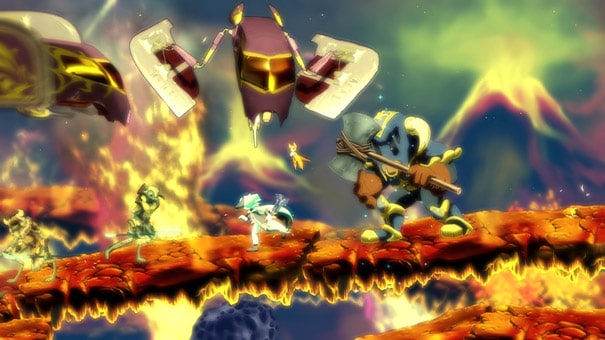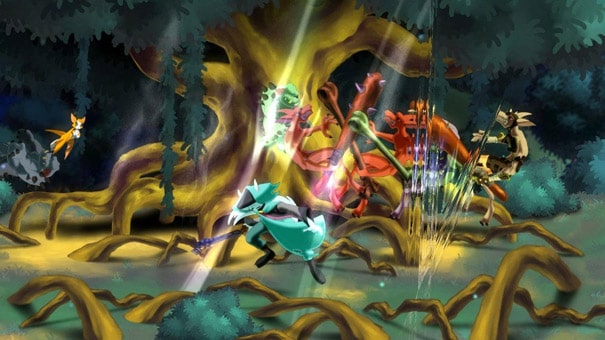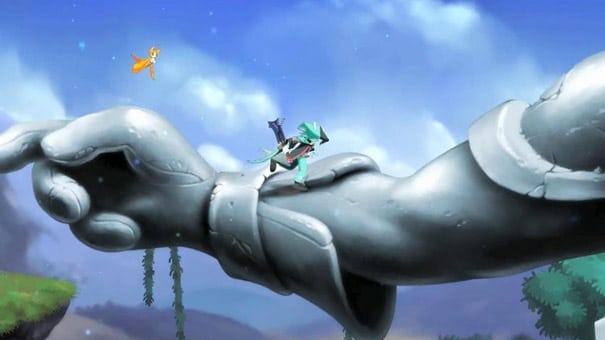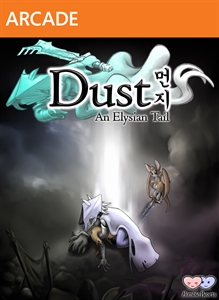Dust: An Elysian Tail marks the close of Microsoft’s Summer of Arcade 2012 promotion, ending things off with a snazzy bang. With over three years of development time, the game weaves an interesting tale from behind the scenes. Primarily developed by one man, Dean “Noggy” Dodrill programmed and did all of the artwork in this side-scrolling ode to the classic action genre of the 16 and 32-bit era of gaming (sound production was handled by HyperDuck SoundWorks). For all of the polish and attention to detail displayed in every screen I’ve experienced in Dust, it can’t be stressed enough how much this bares repeating: one guy did all of this. One guy. I do believe the expression “holy mother of god” sums up my general thoughts quite well.
The story begins with, of course, an amnesiac anthropomorphic warrior (Dust), who finds himself in the company of a flying and highly chatty cat-rat (Fidget) and a giant talking sword (Blade of Ahrah). These three forge a partnership that will take them across five long chapters, with Dust seeking the reasons of his existence, all the while helping out any local village folk he finds on the way. Get used to these three characters, as they form both the trinity and the crux of the game’s arc. Now, don’t get me wrong. I’m a big fan of animated cartoons, most recently being Avatar: The Legend of Korra, and Dust definitely shows a very cartoon-like feeling thanks to its coloured aesthetics and voiced ensemble.
There’s a certain vibe to which Dust as a story tries to establish itself early on – that it’s meant to invoke the struggle of a protagonist searching for his identity, but also reflecting on the friendships and bonds formed over time. While I feel the latter is handled decently, I can’t say as much for the former. Blame it on the numerous times we’ve seen this plot trope employed in so many other mediums, but I found myself more interested in the characters themselves and the situations they were placed in through an optional side quest. And although the amount of voice work is appreciated, it too has its problems. Fidget, being the comic relief she is, will grate at times. And this is more of an observation, but I’m not sure what influenced the idea of having random stereotype accents for particular villagers either.
Regardless, what Dust delivers the most isn’t in its narrative, but it’s incredible focus on ultra satisfying swordplay. Although you only wield a single weapon throughout the game, the ability to mix normal attacks with throws, special moves, and magic casting provide a giddy assortment to experiment with. Imagine turning the combo-heavy antics of Devil May Cry or 3D Ninja Gaiden into a 2D side-scroller, and already you have a good idea of what to expect. The amount of manoeuvrability options, in addition to its tight controls, do a great job in ushering newer players, along with options to tone the difficulty on the fly.
There’s also a level-up and crafting system in place that lets you dabble in your role-playing sensibilities. Each time Dust levels up, you can assign a new skill point to health, attack power, defence, etc. More useful of the two is the ability to craft materials, which you loot from dead monsters, into powerful items that can be equipped. Even better, crafting becomes available to you on the fly as well, so long as you’re able to scout for the required trinket that lets you do so. Unfortunately, certain materials needed for crafting an item display the associated icon but lack a text description of what those materials are supposed to be. One nice touch though, is the ability to sell materials to store vendors. This in turn has them stock them more regularly and thus reduces the amount of backtracking required to attain more material.
It may not seem vital at first, but having a properly decked out character makes a huge difference. Compared to item equipping, level ups in effect feel less emphasised but nonetheless give a welcome award whenever you take out a slew of enemies every few screens or so. And you will kill a lot of creeps in this game, make no mistake. So much so that boss encounters are something of a lost potential here. Comparatively, they are a lot less hectic than having to face a hoard of minions all at once (save for the last battle, which frankly feels more like a prolonged endurance round). Bosses, for the most part, can’t seem to match the game’s overall grandiose design. For instance, it’s odd that your character Dust is able to casually transverse on top of enormous statues, yet the average size of most bosses come nowhere near to rivaling those sizes.
Indeed, Dust is one uber-crazy hack and slash adventure, though not always. To break up the action, there are times when exploration and puzzle solving are crucial to advance. These elements are spaced out accordingly and together make for a considerably less repetitive experience. Exploration helps to drive the amazing art direction that’s often on display, thanks to the many uniquely hand-drawn backgrounds. Sprite animations are silky smooth, with no noticeable drops in the frame rate. Even load times are quick and generally speaking, there’s very little that gets in the way of progression. However, there are times when the overly bright, saturated colours and zoomed out perspective during particular scenes can hinder your vision when there’s simply too much on screen to keep a track of.
Conclusion:
Whatever reservations one will have for the voice acting and overarching saga, the visuals paired with the blistering pace at which you engage enemies carries the emotion of the story fairly well. Even if you have the slightest interest in old-school action games, Dust: An Elysian Tail beckons for your judgement. Standing high on the podium of high-quality XBLA and digital releases overall, very few titles can match its frothing presentation, speediness, and top-dollar value. Should you spend time after completing the eight or so hours it will take to finish the main story, you’ll have numerous treasure chests to uncover, familiar “friends” from other games to save, roughly twenty side quests to plow through, special challenge rooms, leaderboard support and higher difficulty settings to mess around with. Well played, Mr. Dodrill.








